A Longitudinal Multimodal Imaging Study in Patients with Temporo-Insular Diffuse Low-Grade Tumors: How the Inferior Fronto-Occipital Fasciculus Provides Information on Cognitive Outcomes
- PMID: 39727718
- PMCID: PMC11674248
- DOI: 10.3390/curroncol31120595
A Longitudinal Multimodal Imaging Study in Patients with Temporo-Insular Diffuse Low-Grade Tumors: How the Inferior Fronto-Occipital Fasciculus Provides Information on Cognitive Outcomes
Abstract
Background: Tractography allows the in vivo study of subcortical white matter, and it is a potential tool for providing predictive indices on post-operative outcomes. We aim at establishing whether there is a relation between cognitive outcome and the status of the inferior fronto-occipital fasciculus's (IFOF's) microstructure.
Methods: The longitudinal neuropsychological data of thirty young (median age: 35 years) patients operated on for DLGG in the left temporo-insular cortex along with pre-surgery tractography data were processed.
Results: A degraded integrity of the left (vs. right) IFOF (lower fractional anisotropy and length, p < 0.001; higher mean and axial diffusivity, p < 0.01) was found, with lower microstructural variables in the infiltration (vs. dislocation) group. Significant decreases immediately post-surgery vs. pre-surgery mainly occurred in lexico-semantics (p < 0.001), with significant improvements at follow-up in all the tests (p < 0.01 to p < 0.001), despite values in the range of 44% to 47.82% of patients with below cut-off scores regarding naming verbs and making visual lexical decisions. The status of left and right IFOFs is predictive of a decrease in immediate post-surgery performance for several tests (p < 0.05); similarly, it is predictive of better recovery in the follow-up performance for naming nouns, naming verbs, making phonological fluency lexical decisions, and the token test (p < -0.05). For the ROC analysis, a significant result was obtained for the verb-naming test, with a cut-off of 79%.
Conclusions: This study supports the role of the predictive value of pre-operative tractography for assessing the immediate post-operative result and at follow-up the risk of developing a cognitive deficit.
Keywords: fiber tracking; inferior fronto-occipital fasciculus; lower-grade gliomas; microstructure analysis; neuropsychology; predictive value.
Conflict of interest statement
The authors declare no conflicts of interest.
Figures





References
-
- Skrap M., Mondani M., Tomasino B., Weis L., Budai R., Pauletto G., Eleopra R., Fadiga L., Ius T. Surgery of insular nonenhancing gliomas: Volumetric analysis of tumoral resection, clinical outcome, and survival in a consecutive series of 66 cases. Neurosurgery. 2012;70:1081–1093; discussion 1093–1094. doi: 10.1227/NEU.0b013e31823f5be5. - DOI - PubMed
-
- Martino J., Mato D., de Lucas E.M., García-Porrero J.A., Gabarrós A., Fernández-Coello A., Vázquez-Barquero A. Subcortical anatomy as an anatomical and functional landmark in insulo-opercular gliomas: Implications for surgical approach to the insular region. J. Neurosurg. 2015;123:1081–1092. doi: 10.3171/2014.11.JNS141992. - DOI - PubMed
MeSH terms
Grants and funding
LinkOut - more resources
Full Text Sources
Medical

